Abstract
Baker, Phillip J. (University of Wisconsin, Madison), and J. B. Wilson. Chemical composition and biological properties of the endotoxin of Brucella abortus. J. Bacteriol. 90:895–902. 1965.—The ability of endotoxin to induce hypoferremia in mice was used to measure the specific activity of various endotoxin preparations of Escherichia coli and Brucella abortus and to determine the endotoxin content of several strains of B. abortus differing in virulence for guinea pigs. The endotoxin preparations from E. coli possessed greater biological activity than those from B. abortus. The same types of B. abortus endotoxin preparations, whether obtained from strains of high or low virulence, had about the same activity. Although differences in endotoxin content were noted among several strains of B. abortus of different virulence, there appeared to be no correlation between endotoxin content and virulence. Chemical analyses of B. abortus and E. coli endotoxins, based upon nitrogen, phosphorus, fatty acid ester, fatty acid amide, total fatty acids, hexose, and hexosamine content, revealed differences in chemical composition; however, these differences could not be correlated with differences in biological activity. The same types of endotoxin preparations, whether obtained from strains of B. abortus of high or low virulence, were similar in chemical composition and in biological activity. A correlation between the ability of endotoxin to induce hypoferremia and its lethal effects in mice is suggested. In general, endotoxin preparations of high hypoferremic activity had low mouse ld50 values.
Full text
PDF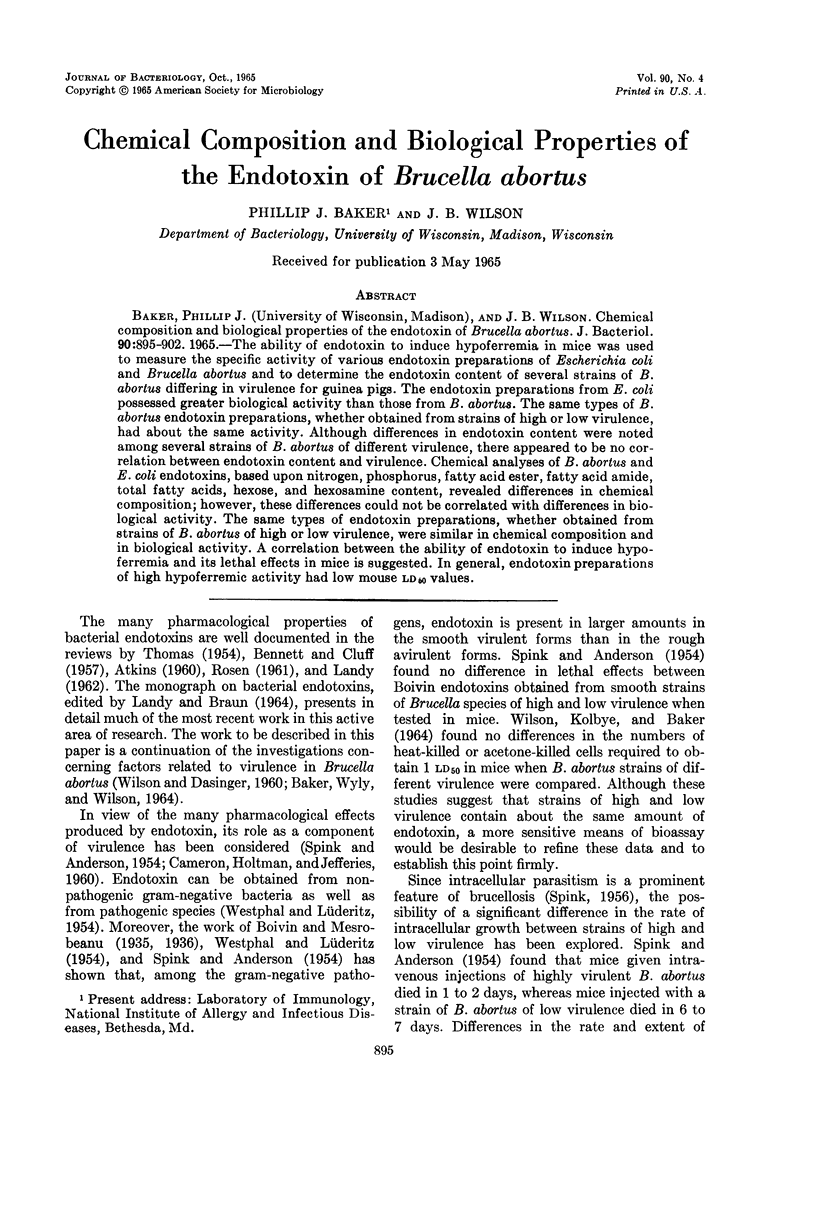
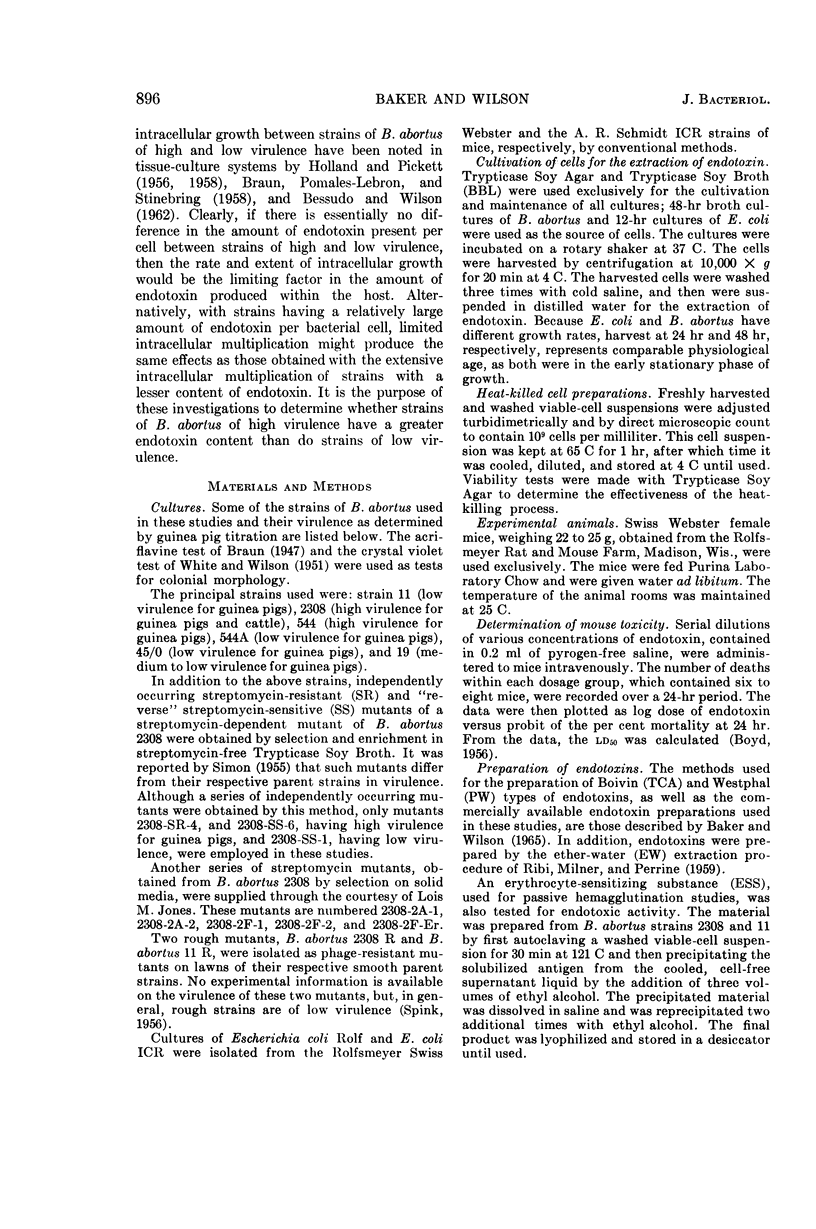
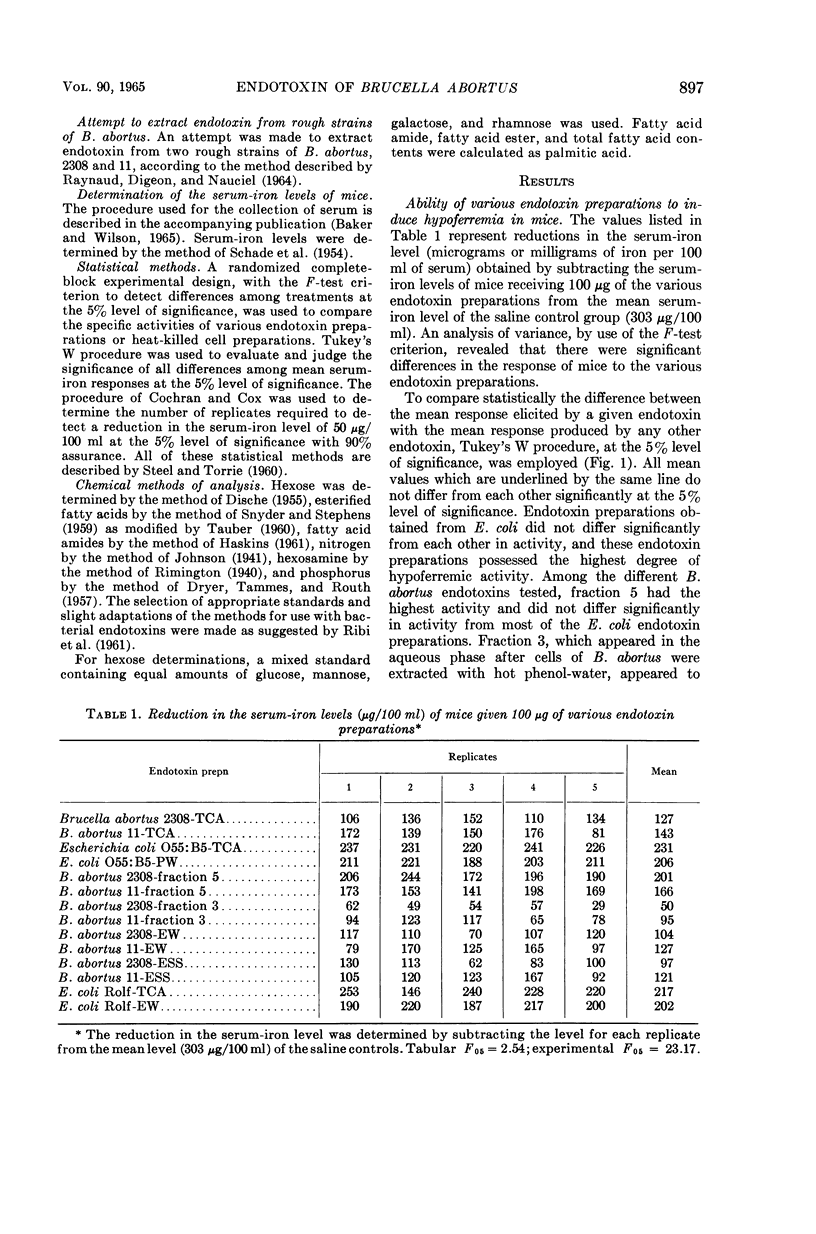


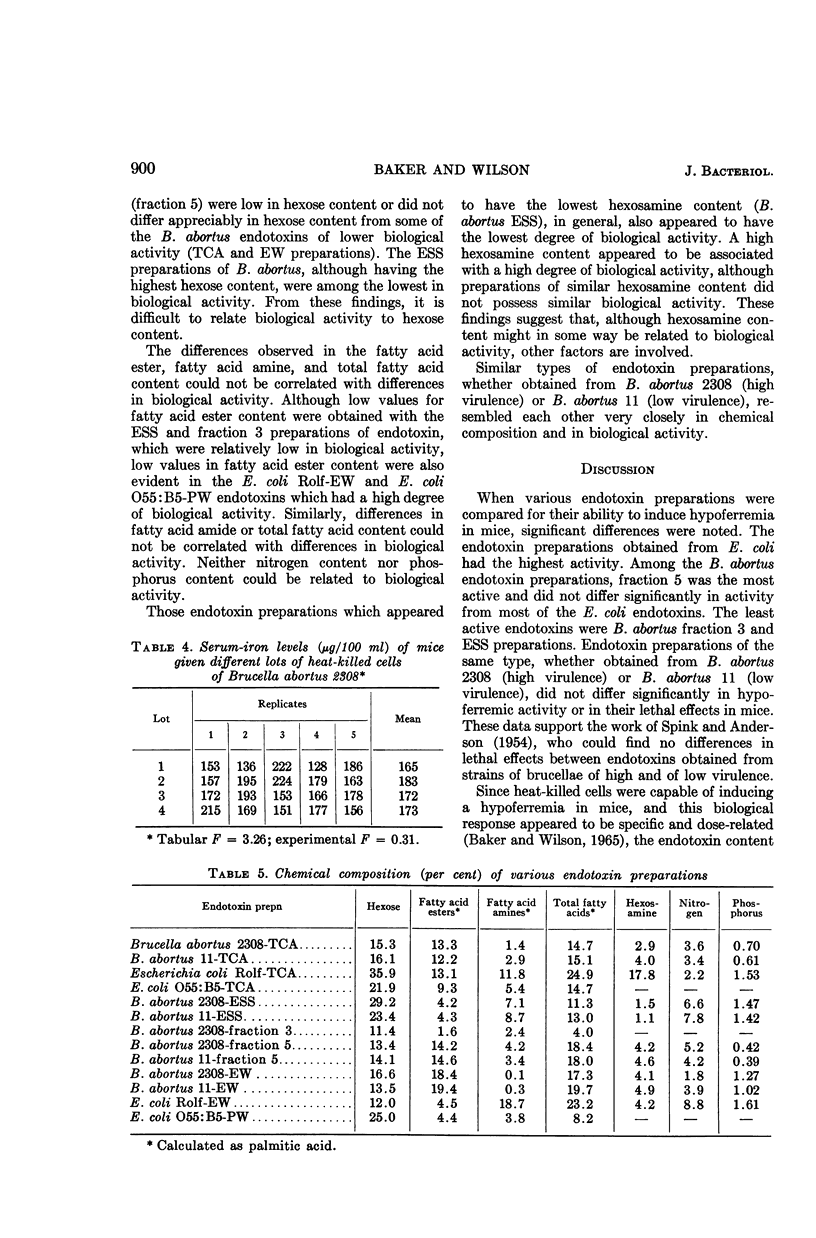
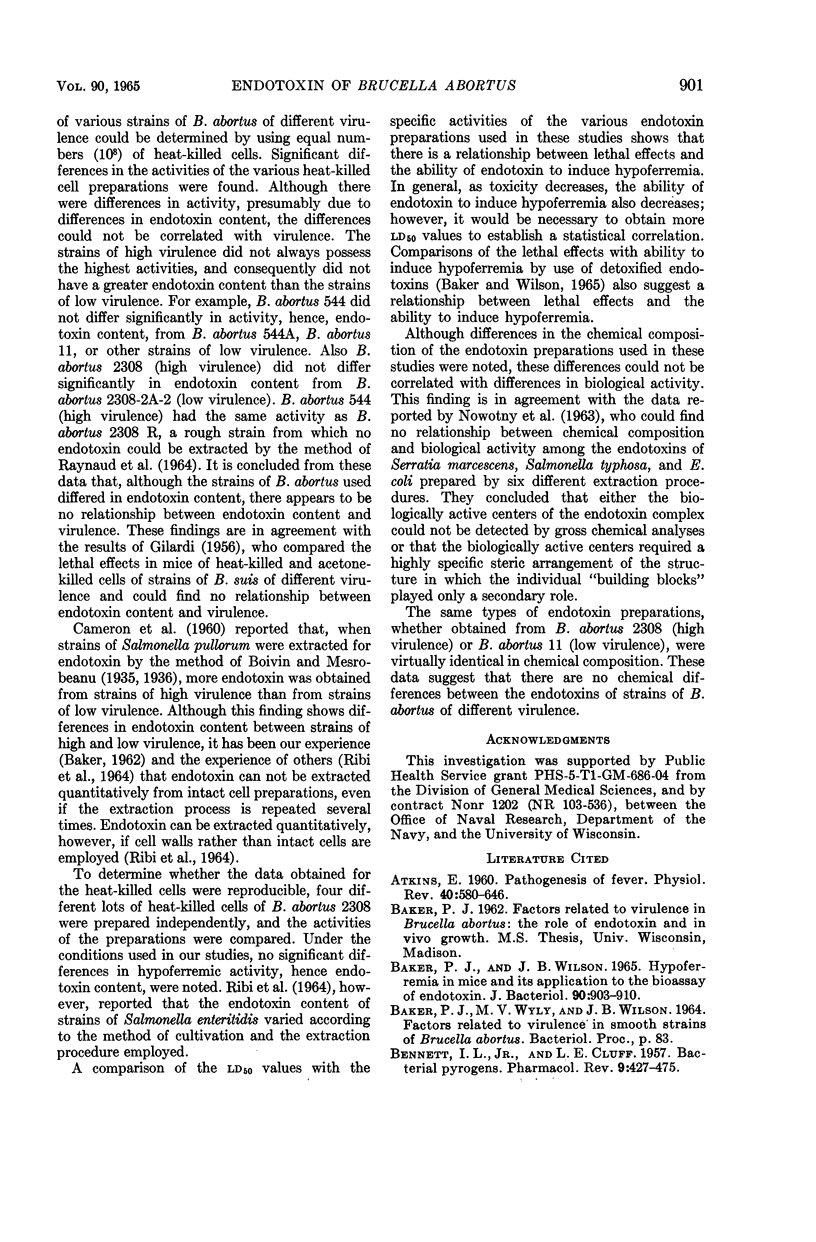
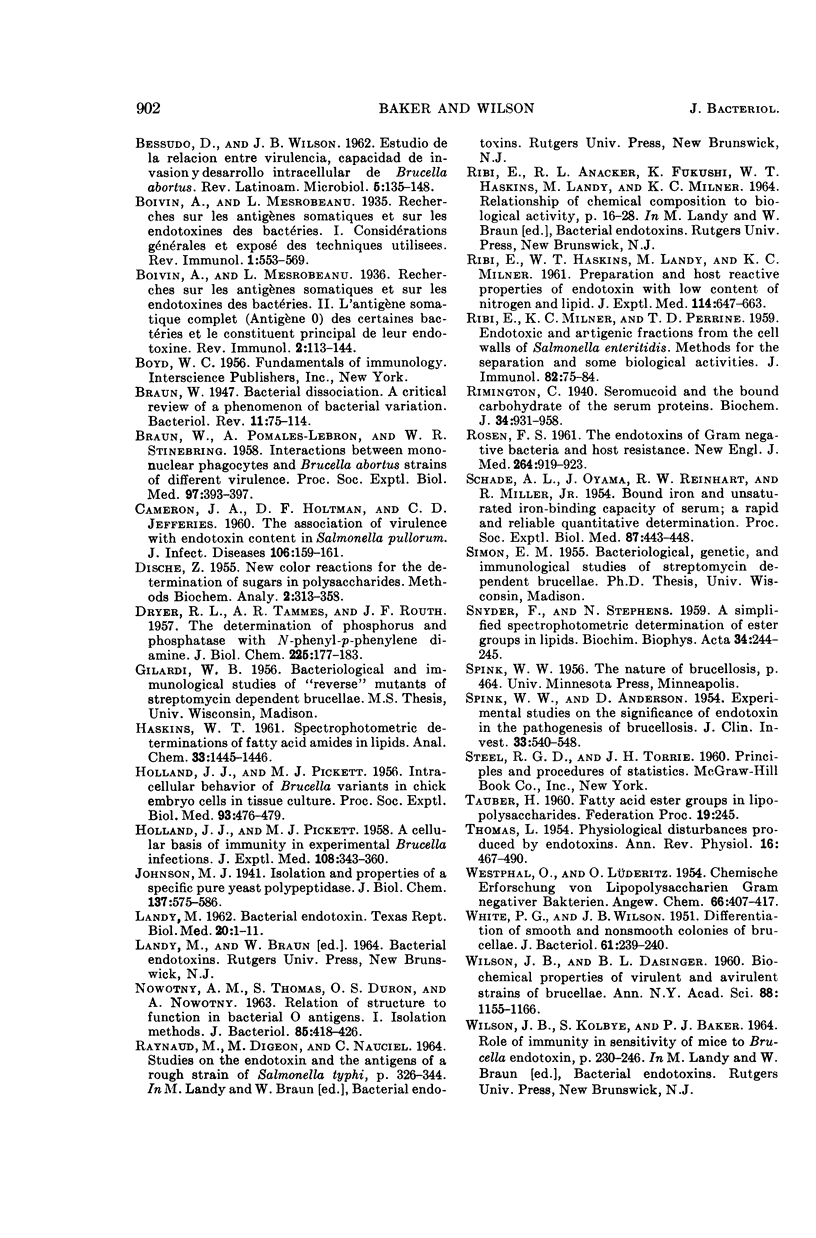
Selected References
These references are in PubMed. This may not be the complete list of references from this article.
- ATKINS E. Pathogenesis of fever. Physiol Rev. 1960 Jul;40:580–646. doi: 10.1152/physrev.1960.40.3.580. [DOI] [PubMed] [Google Scholar]
- BENNETT I. L., Jr, CLUFF L. E. Bacterial pyrogens. Pharmacol Rev. 1957 Dec;9(4):427–479. [PubMed] [Google Scholar]
- BRAUN W., POMALES-LEBRON A., STINEBRING W. R. Interactions between mononuclear phagocytes and Brucella abortus strains of different virulence. Proc Soc Exp Biol Med. 1958 Feb;97(2):393–397. doi: 10.3181/00379727-97-23752. [DOI] [PubMed] [Google Scholar]
- Baker P. J., Wilson J. B. Hypoferremia in mice and its application to the bioassay of endotoxin. J Bacteriol. 1965 Oct;90(4):903–910. doi: 10.1128/jb.90.4.903-910.1965. [DOI] [PMC free article] [PubMed] [Google Scholar]
- Braun W. BACTERIAL DISSOCIATION: A Critical Review of a Phenomenon of Bacterial Variation. Bacteriol Rev. 1947 Jun;11(2):75–114. doi: 10.1128/br.11.2.75-114.1947. [DOI] [PMC free article] [PubMed] [Google Scholar]
- CAMERON J. A., HOLTMAN D. F., JEFFRIES C. D. The association of virulence with endotoxin in Salmonella pullorum. J Infect Dis. 1960 Mar-Apr;106:159–161. doi: 10.1093/infdis/106.2.159. [DOI] [PubMed] [Google Scholar]
- DISCHE Z. New color reactions for determination of sugars in polysaccharides. Methods Biochem Anal. 1955;2:313–358. doi: 10.1002/9780470110188.ch11. [DOI] [PubMed] [Google Scholar]
- DRYER R. L., TAMMES A. R., ROUTH J. I. The determination of phosphorus and phosphatase with N-phenyl-p-phenylenediamine. J Biol Chem. 1957 Mar;225(1):177–183. [PubMed] [Google Scholar]
- HOLLAND J. J., PICKETT M. J. A cellular basis of immunity in experimental Brucella infection. J Exp Med. 1958 Sep 1;108(3):343–360. doi: 10.1084/jem.108.3.343. [DOI] [PMC free article] [PubMed] [Google Scholar]
- HOLLAND J. J., PICKETT M. J. Intracellular behavior of Brucella variants in chick embryo cells in tissue culture. Proc Soc Exp Biol Med. 1956 Dec;93(3):476–479. doi: 10.3181/00379727-93-22792. [DOI] [PubMed] [Google Scholar]
- NOWOTNY A. M., THOMAS S., DURON O. S., NOWOTNY A. Relation of structure to function in bacterial O antigens. I. Isolation methods. J Bacteriol. 1963 Feb;85:418–426. doi: 10.1128/jb.85.2.418-426.1963. [DOI] [PMC free article] [PubMed] [Google Scholar]
- RIBI E., HASKINS W. T., LANDY M., MILNER K. C. Preparation and host-reactive properties of endotoxin with low content of nitrogen and lipid. J Exp Med. 1961 Nov 1;114:647–663. doi: 10.1084/jem.114.5.647. [DOI] [PMC free article] [PubMed] [Google Scholar]
- RIBI E., MILNER K. C., PERRINE T. D. Endotoxic and antigenic fractions from the cell wall of Salmonella enteritidis; methods for separation and some biologic activities. J Immunol. 1959 Jan;82(1):75–84. [PubMed] [Google Scholar]
- ROSEN F. S. The endotoxins of gram-negative bacteria and host resistance. N Engl J Med. 1961 May 4;264:919–923. doi: 10.1056/NEJM196105042641807. [DOI] [PubMed] [Google Scholar]
- Rimington C. Seromucoid and the bound carbohydrate of the serum proteins. Biochem J. 1940 Jun;34(6):931–940. doi: 10.1042/bj0340931. [DOI] [PMC free article] [PubMed] [Google Scholar]
- SCHADE A. L., OYAMA J., REINHART R. W., MILLER J. R. Bound iron and unsaturated iron-binding capacity of serum; rapid and reliable quantitative determination. Proc Soc Exp Biol Med. 1954 Nov;87(2):443–448. doi: 10.3181/00379727-87-21407. [DOI] [PubMed] [Google Scholar]
- SNYDER F., STEPHENS N. A simplified spectrophotometric determination of ester groups in lipids. Biochim Biophys Acta. 1959 Jul;34:244–245. doi: 10.1016/0006-3002(59)90255-0. [DOI] [PubMed] [Google Scholar]
- SPINK W. W., ANDERSON D. Experimental studies on the significance of endotoxin in the pathogenesis of brucellosis. J Clin Invest. 1954 Apr;33(4):540–548. doi: 10.1172/JCI102924. [DOI] [PMC free article] [PubMed] [Google Scholar]
- THOMAS L. The physiological disturbances produced by endotoxins. Annu Rev Physiol. 1954;16:467–490. doi: 10.1146/annurev.ph.16.030154.002343. [DOI] [PubMed] [Google Scholar]
- WHITE P. G., WILSON J. B. Differentiation of smooth and nonsmooth colonies of Brucellae. J Bacteriol. 1951 Feb;61(2):239–240. doi: 10.1128/jb.61.2.239-240.1951. [DOI] [PMC free article] [PubMed] [Google Scholar]
- WILSON J. B., DASINGER B. L. Biochemical properties of virulent and avirulent strains of brucellae. Ann N Y Acad Sci. 1960 Nov 21;88:1155–1166. doi: 10.1111/j.1749-6632.1960.tb20106.x. [DOI] [PubMed] [Google Scholar]


